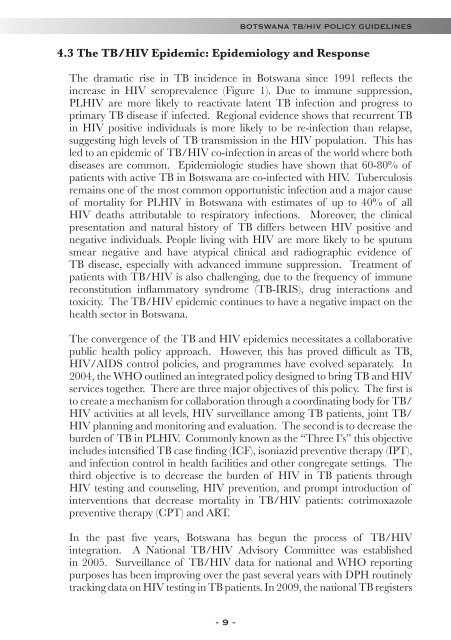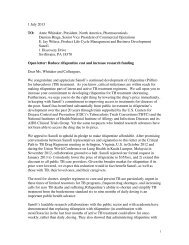BOTSWANA TB/HIV POLICY GUIDELINES - TB Online
BOTSWANA TB/HIV POLICY GUIDELINES - TB Online
BOTSWANA TB/HIV POLICY GUIDELINES - TB Online
Create successful ePaper yourself
Turn your PDF publications into a flip-book with our unique Google optimized e-Paper software.
<strong>BOTSWANA</strong> <strong>TB</strong>/<strong>HIV</strong> <strong>POLICY</strong> <strong>GUIDELINES</strong><br />
4.3 The <strong>TB</strong>/<strong>HIV</strong> Epidemic: Epidemiology and Response<br />
The dramatic rise in <strong>TB</strong> incidence in Botswana since 1991 reflects the<br />
increase in <strong>HIV</strong> seroprevalence (Figure 1). Due to immune suppression,<br />
PL<strong>HIV</strong> are more likely to reactivate latent <strong>TB</strong> infection and progress to<br />
primary <strong>TB</strong> disease if infected. Regional evidence shows that recurrent <strong>TB</strong><br />
in <strong>HIV</strong> positive individuals is more likely to be re-infection than relapse,<br />
suggesting high levels of <strong>TB</strong> transmission in the <strong>HIV</strong> population. This has<br />
led to an epidemic of <strong>TB</strong>/<strong>HIV</strong> co-infection in areas of the world where both<br />
diseases are common. Epidemiologic studies have shown that 60-80% of<br />
patients with active <strong>TB</strong> in Botswana are co-infected with <strong>HIV</strong>. Tuberculosis<br />
remains one of the most common opportunistic infection and a major cause<br />
of mortality for PL<strong>HIV</strong> in Botswana with estimates of up to 40% of all<br />
<strong>HIV</strong> deaths attributable to respiratory infections. Moreover, the clinical<br />
presentation and natural history of <strong>TB</strong> differs between <strong>HIV</strong> positive and<br />
negative individuals. People living with <strong>HIV</strong> are more likely to be sputum<br />
smear negative and have atypical clinical and radiographic evidence of<br />
<strong>TB</strong> disease, especially with advanced immune suppression. Treatment of<br />
patients with <strong>TB</strong>/<strong>HIV</strong> is also challenging, due to the frequency of immune<br />
reconstitution inflammatory syndrome (<strong>TB</strong>-IRIS), drug interactions and<br />
toxicity. The <strong>TB</strong>/<strong>HIV</strong> epidemic continues to have a negative impact on the<br />
health sector in Botswana.<br />
The convergence of the <strong>TB</strong> and <strong>HIV</strong> epidemics necessitates a collaborative<br />
public health policy approach. However, this has proved difficult as <strong>TB</strong>,<br />
<strong>HIV</strong>/AIDS control policies, and programmes have evolved separately. In<br />
2004, the WHO outlined an integrated policy designed to bring <strong>TB</strong> and <strong>HIV</strong><br />
services together. There are three major objectives of this policy. The first is<br />
to create a mechanism for collaboration through a coordinating body for <strong>TB</strong>/<br />
<strong>HIV</strong> activities at all levels, <strong>HIV</strong> surveillance among <strong>TB</strong> patients, joint <strong>TB</strong>/<br />
<strong>HIV</strong> planning and monitoring and evaluation. The second is to decrease the<br />
burden of <strong>TB</strong> in PL<strong>HIV</strong>. Commonly known as the “Three I’s” this objective<br />
includes intensified <strong>TB</strong> case finding (ICF), isoniazid preventive therapy (IPT),<br />
and infection control in health facilities and other congregate settings. The<br />
third objective is to decrease the burden of <strong>HIV</strong> in <strong>TB</strong> patients through<br />
<strong>HIV</strong> testing and counseling, <strong>HIV</strong> prevention, and prompt introduction of<br />
interventions that decrease mortality in <strong>TB</strong>/<strong>HIV</strong> patients: cotrimoxazole<br />
preventive therapy (CPT) and ART.<br />
In the past five years, Botswana has begun the process of <strong>TB</strong>/<strong>HIV</strong><br />
integration. A National <strong>TB</strong>/<strong>HIV</strong> Advisory Committee was established<br />
in 2005. Surveillance of <strong>TB</strong>/<strong>HIV</strong> data for national and WHO reporting<br />
purposes has been improving over the past several years with DPH routinely<br />
tracking data on <strong>HIV</strong> testing in <strong>TB</strong> patients. In 2009, the national <strong>TB</strong> registers<br />
- 9 -






